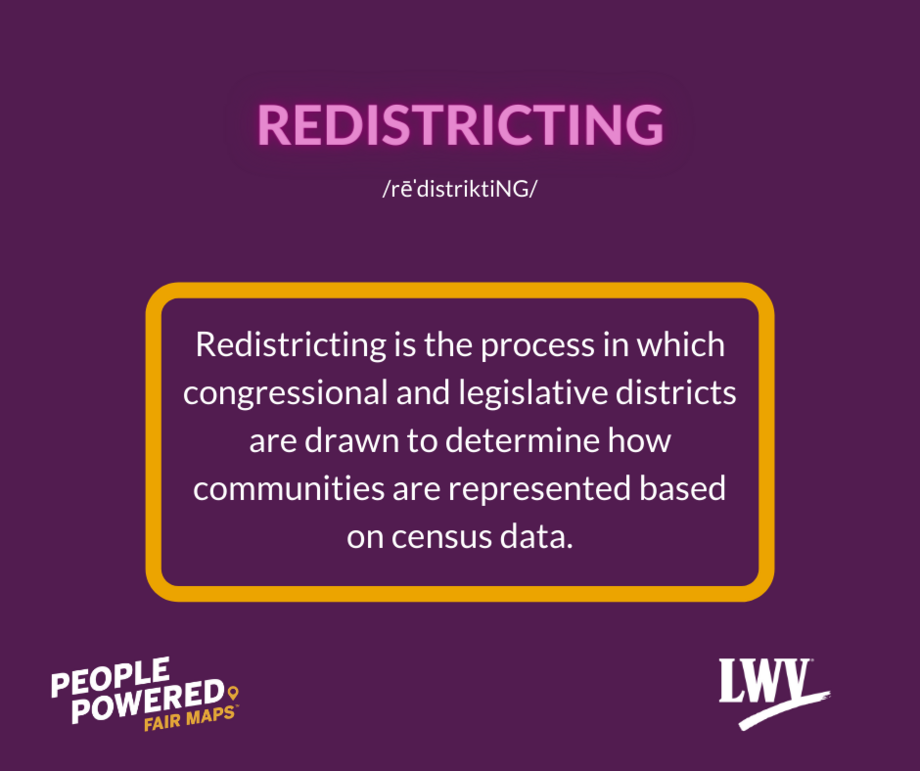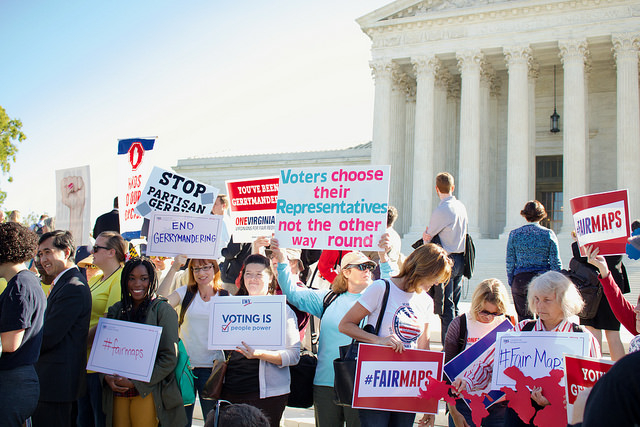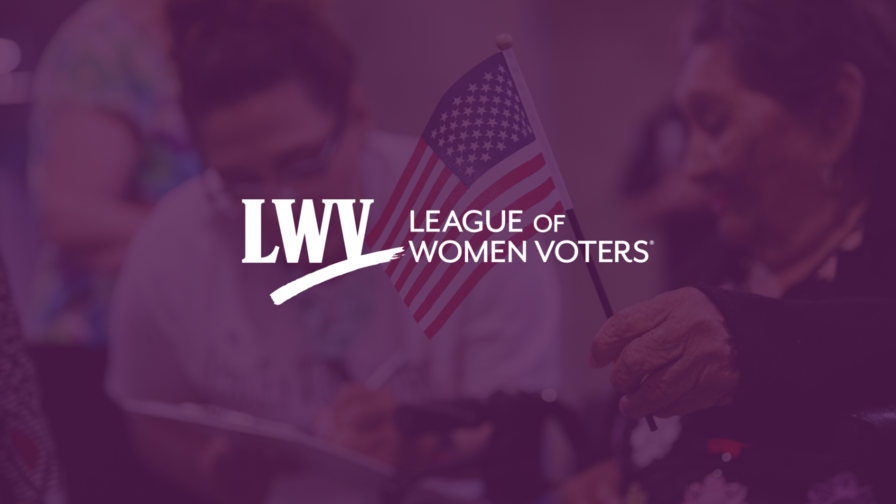What is "One Person, One Vote?"
The Equal Protection Clause of the Fourteenth Amendment guarantees that the government cannot “deny to any person within its jurisdiction the equal protection of the laws.” That protection applies to voting rights and fair elections in two critical ways: equal access to the ballot and equal representation in government.
Redistricting and Equal Protection Under the Law
Protecting our election laws and systems from disinformation and elimination is more urgent than ever. And ensuring that our nation’s redistricting processes promote fair representation is part of giving all people equal protection of the laws, as it gives everyone an equal opportunity to elect the representatives who make those laws.
Lyle Dennison of the National Constitution Center notes that “it is essential to the core theory of a democracy that the people rule, and do so with equal political authority.” When redistricting is done fairly, each person’s vote is equal to every other person’s vote because their districts are drawn in ways that accurately represent the voting power of the people within them. When that happens, members of our democracy can rest assured their votes are meaningful.
When redistricting is done unfairly, however, and maps are created to favor one party (partisan gerrymandering) or with race as the predominant factor (racial gerrymandering), voters in certain districts are given more power than others.

In past redistricting periods, many US states failed to redraw their congressional districts even though new demographic information becomes available every ten years through the US Census. The result was that electoral maps often did not reflect large-scale changes in population, race, place, and other trends.
For example, in the nineteenth century, the Industrial Revolution and increased immigration meant cities grew exponentially as people migrated from the countryside. Yet despite these changes, the boundaries of many election districts remained the same. People in rural areas — which skew white and conservative — came to exercise outsized influence on election outcomes compared to their urban counterparts. A rural district might contain 250,000 people, while an urban district had 500,000, but both had one representative in Congress.
The Origin of One Person, One Vote
With its 1962 decision in Baker v. Carr, the US Supreme Court established that redistricting questions are justiciable (meaning they are legal questions the courts can resolve rather than political questions left to legislators) under the Equal Protection Clause. Then, the Court’s 1964 decision in Reynolds v. Sims established the “one person, one vote” (OPOV) doctrine, which requires every state legislative district to contain roughly the same number of people. When each representative has the same number of constituents, people are equally represented, and their votes have an equal opportunity to influence policies in their state.
That same year, the Court extended the OPOV doctrine to apply to US Congressional districts in Wesberry v. Sanders. The Court clarified that districts should aim for mathematical equality even though some deviations are constitutionally permissible — especially if a legitimate state policy justifies them.
Yet, while the Court declared the total population of each district should be equal, it did not define “total population” for redistricting purposes; specifically, it did not specify whether the total population should include only registered voters or all people residing in a district. It did not answer these questions: should non-citizen residents, children, or adults who aren’t registered to vote be counted?
There are many reasons to support counting non-voters among the total population. People who do not vote still live within our society, and the laws and policies that govern us impact their lives. Defining “total population” as all persons residing in a district, rather than only US citizens, only registered voters, or only adults (all of which are approaches proposed by some state officials) protects racial and ethnic minorities and children whose interests are already marginalized and gives them a voice in our democracy.
Get involved in ensuring fair representation in your community by joining the League!
The question of total population’s definition was raised in the 2016 case Evenwel v. Abbott, which challenged the idea that every person, regardless of voter registration status, should have equal representation. Ultimately, the Supreme Court found that states may use their entire population, including non-registered voters, to draw election maps. However, the Court noted that states are not compelled to use this measure and may also use voting age population or the number of registered voters to draw election maps.
Obstacles to One Person, One Vote
Several challenges to achieving truly equal representation remain.
Prison Gerrymandering
For one thing, the nation’s mass incarceration crisis and the failure of states to repeal racist felony disenfranchisement laws rooted in the Jim Crow era prevent them from providing equal representation. Under current US Census rules, incarcerated people are counted as residents of the district where they are imprisoned. This practice is known as prison gerrymandering. This artificially inflates the number of representatives for rural areas, where most state prisons are located, even though a majority of incarcerated people come from urban areas.
Most people in prison can’t vote, and their interests are not represented by legislators in the districts who technically represent them. They neither vote for these representatives nor participate in the community where the prison is located. In fact, representatives in districts with prisons have an incentive to keep people incarcerated to pad their district’s population and increase the clout of the free people they represent.
Malapportionment
Malapportionment, or drawing districts that violate the OPOV principle, also makes it easier for state legislatures to engage in partisan gerrymandering. Legislators may rig maps to favor certain political parties by “packing” unfavorable voters into one district to limit their influence in other districts, or by “cracking” unfavorable communities of interest to dilute their voting power and prevent them from electing the candidates of their choice.
Uncompetitive Elections
Furthermore, current methods of redistricting result in the large majority of elections being uncompetitive, meaning the winner prevails by 15 or more percentage points. Most Americans don’t realize that more competitive elections can be a positive force that encourages representatives to be more responsive to the needs of their constituents and to act on the concerns of a broader base of voters.

The Electoral College
The Electoral College is a group of appointed individuals from each state responsible for selecting the US president and vice president. The system is rooted in racism and slavery and violates OPOV because less populated states have an outsized influence on the number of electors compared to their more populated counterparts. Each state’s number of electors is based on its representatives in Congress, which also does not conform to OPOV since every state has two Senators regardless of population. What’s more, in most states, all Electoral College votes go to the candidate with the most votes, meaning your vote essentially has no effect unless you voted for the winner.
How People are Supporting One Person, One Vote
To remedy these issues, an increasing number of jurisdictions are considering ranked choice and other forms of voting that experts believe conform to the OPOV doctrine more closely than the “winner-takes-all” voting system we have now. Ranked choice, for example, allows voters to rank candidates in order of preference so that if their first choice doesn’t win, their vote for their second-choice candidate is counted. State and local Leagues have worked to advocate and implement ranked choice voting in their communities.
To combat prison gerrymandering, the Census released data on where incarcerated people resided before being convicted. A few states have passed laws stipulating prisoners will be counted in those districts for voting maps.
Voting rights advocates continue to advocate for restoring the Voting Rights Act to its full strength. The League of Women Voters is committed to increasing voter participation and education and creating fair political maps nationwide. Contact your local and state Leagues today to learn more about LWV’s national redistricting effort, People Powered Fair Maps™, and to find out how you can get involved.
The Latest from the League
RALEIGH — The League of Women Voters of North Carolina President Jo Nicholas released the following statement after the North Carolina Supreme Court took unprecedented action and reversed its prior ruling that North Carolina’s congressional and state legislative maps were unconstitutional partisan gerrymanders under the state Constitution:
In September 2019, the League launched its national redistricting effort People Powered Fair Maps™ (PPFM).
PPFM aimed to create greater transparency, fairness, and public participation in the redistricting process, which determines voting access, partisan representation, and federal funding for communities across the country.
Sign Up For Email
Keep up with the League. Receive emails to your inbox!
Donate to support our work
to empower voters and defend democracy.





